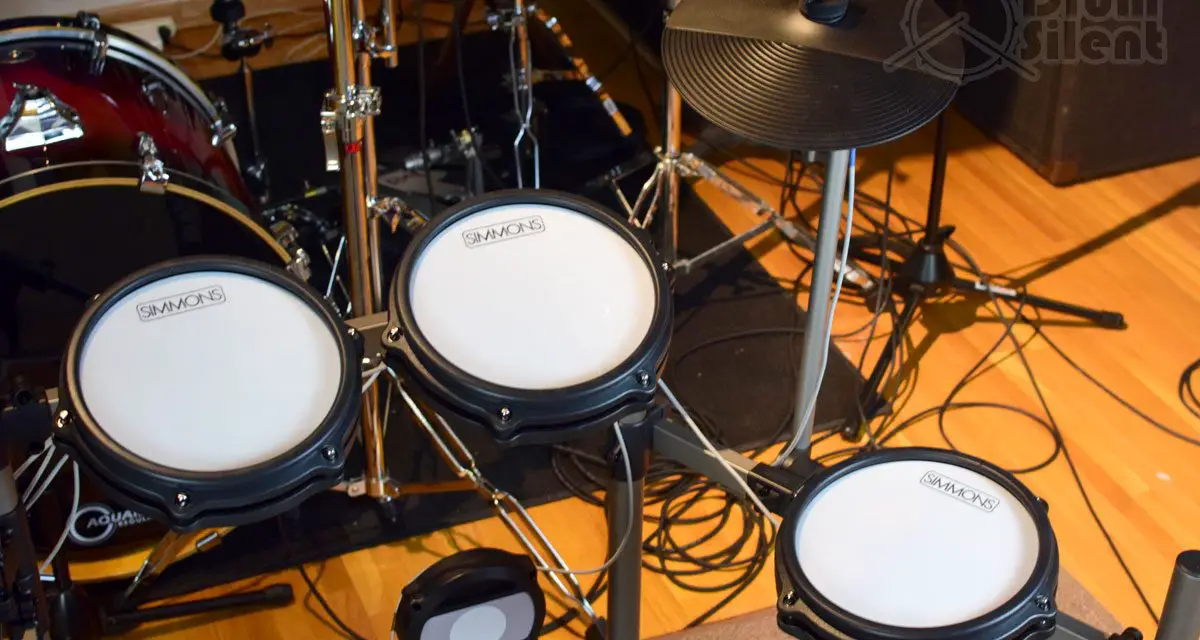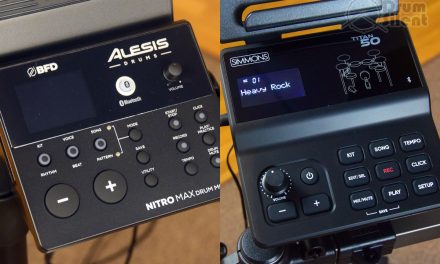It’s possible to get excellent recordings from both acoustic and electronic drums, but there certainly are some advantages and disadvantages for both. Electronic drums can be technically easier to record but can sound more artificial depending on the recording processes and techniques used to bring the recorded tracks to completion.
Acoustical Concerns Between Recording Electronic and Acoustic Drum Kits
To capture quality recordings of acoustic drums, there are a wide range of acoustical challenges that can make it more difficult. Things such as the room you are recording in, mics you are using and the quality of the drum equipment will all come into play.
The room type, size and acoustical treatment is a big concern. Recording in a room with bad acoustical properties will make it more challenging to capture a quality drum sound. The room can also limit the type of drum sound you can capture. A very dry, small room with little natural reverb can capture a tight, clean drum sound and give more room for adding effects during post processing. A larger room might have more natural reverb and allow you to capture a more spacious or distant sound. A room that isn’t acoustically treated can present other problems as well.
Recording an electronic drum kit eliminates all the acoustic issues since you’re recording the audio output or the MIDI output from the drum module. It doesn’t matter what type of room your electronic drum kit is in. What matters is the sounds that the module can produce or the sounds you can get from drum VST’s on your computer.
Quality Drums, Cymbals and Harware
When you record acoustic drums, the recording will only sound as good as the drums you are recording. If you’re using drums that just don’t sound that great, you’ll have a hard time making them sound good in post-processing. Tuning your drums and getting them to sound great before hitting the record button is very important. Even if you have nice drums, getting them to sound good before recording can still take time, patience and some trial and error.
The same can be said about cymbals and other gear around the kit. Cracked cymbals might work fine for practice but they can sound awful on a recording. Squeaky kick drum pedals, rattling stands and creaking drum thrones will be an issue during recording.
Recording electronic drums eliminates a lot of those issues. You won’t have to worry about tuning the drums or if your pedals are squeaky, which can be an advantage.
Miking An Acoustic Drum Kit
To record an acoustic drum kit you’ll need to use microphones. This is an extra expense for sure, and drum kit miking can be a whole other topic of discussion on it’s own. Learning how to position the microphones can take some practice and experience, but it’s not terribly complicated once you get the basic concepts down. You’ll also need to use an audio interface or mixer than can support the number of microphones you want to use. Then there’s also the cables. And potential need for phantom power to power certain types of microphones. Miking up a drum kit for recording can turn into a gear acquisition rabbit hole pretty quickly.
To record an electronic drum kit you don’t need any microphones at all, which is an advantage. At most you’ll need to connect a MIDI cable or a USB cable, or in some cases audio cables to capture the performance.
Noise Factors
When recording acoustic drums you’ll find that any background noise can quite easily show up in the recorded tracks and can cause issues. If you’re using room and overhead mics, background sounds can be even worse to deal with than if you’re just direct miking all the drums. You’ll find that you pretty much need a soundproof room to eliminate background noise. Ventilation systems, computer fans, fridges, outside traffic, door slamming and more can be an issue when recording acoustic drums in a place like your home.
Electronic drums won’t have this issue since you’re not recording what’s going on acoustically in the room. You can record electronic drums in noisier environments and not have to worry about background and environmental noise.
Artificial Sounding Drum Tracks From Electronic Drums
The biggest issue with recording electronic drums, at least in my opinion, is that it can sound more artificial and potentially too clean depending on how you mix the captured tracks.
If you’re going to record the audio output from your electronic drum kit, you’ll be relying on the sounds in the drum module and if the sounds aren’t that great, it will be reflected in the recording. The sounds can potentially sound more separated and not meshing and interacting with each other the way the sounds of an acoustic drum kit will.
When playing and recording and acoustic drum kit, resonance and sounds from the drums and cymbals can overlap and interact with each other in a satisfying way, making the kit feel more like a single piece of gear as opposed to separate pieces. The bleed between microphones around the kit also helps to make the sounds around the entire kit feel more gelled together as well.
Because of this, it can be worthwhile to take the time to try to create or simulate a room mic mix and/or overhead mic mix when recording electronic drums. This will help mesh the sounds together in a more organic way that can make the drums sound more natural and remove that clean edge that electronic drums can sometimes have. Some drum modules include an overhead or room mic mix in the module itself. Drum VST’s often have this feature as well.
Post-Processing and Editing Recorded Tracks
If you record the MIDI output from an electronic drum kit you’ll set yourself up with tracks that can be very easily fixed or edited after recording. MIDI is the best for this, since you can basically edit, rearrange, quantize or even delete or add more notes as you see fit after you record the tracks. This can make it very easy to take tracks that aren’t perfect and make them sound exactly how you want in terms of timing and groove with a little bit of editing. With MIDI tracks, you can also completely replace drum sounds after recording.
If you record multi-track audio output from a drum module you can often do the same, but with a little less freedom when compared to MIDI tracks. One potential advantage with recording multi-track audio from the drum module is that there won’t be any bleed between the audio tracks like you’d get with a miked up acoustic drum kit. So even though you have audio tracks, you can edit them independently much more easily.
When recording an acoustic drum kit, even though you can mic all the drums separately if you want, you still have bleed between all the mics. This can make it much more tricky to edit timing on tracks individually. For example, if you want to fix some timing on the snare drum track, you can still potentially hear the snare drum in the toms or room/overhead mics, and you’ll soon realize it’s going to be a lot more tricky than just editing the snare drum track.
Which Will Be The Better Option For Recording?
As with most things, it comes down to your circumstances and situation. As you can see, there are some different requirements and advantages when recording acoustic and electronic drums.
If you have the ability to set up a fairly soundproofed and acoustically treated room, don’t mind spending money on microphones and audio interfaces, and don’t mind taking the time to experiment with learning how to capture a decent recording from an acoustic kit, recording acoustic drums can be a satisfying experience. The results can be much more organic and natural which can be ideal for many types of music. You’ll also feel more pressure to lay down a good performance as a drummer since it’s harder to fix mistakes when recording acoustic drums.
If you don’t have access to a proper room for recording, and if you don’t have quality acoustic drums and other equipment such as microphones and multi-track interfaces, electronic drums can be a good recording option. As far as electronic drums go, they can be much more plug and play when recording. You won’t need to spend nearly as much time setting up and sound testing to get everything ready to go when compared to acoustic drums. And you can even record electronic drums in places like apartments. With a little practice and experience, and with the right drum VST’s and software, you can create very convincing drum tracks with electronic drums that can mimic the sound of recorded acoustic drums.







